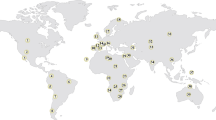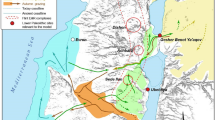Abstract
This review explores the great copper alloy image casting traditions of southern India from archaeometallurgical and ethnometallurgical perspectives. The usefulness of lead isotope ratio and compositional analysis in the finger-printing and art historical study of more than 130 early historic, Pallava, Chola, later Chola, and Vijayanagara sculptures (fifth–eighteenth centuries) is highlighted, including Nataraja, Buddha, Parvati, and Rama images made of copper, leaded bronze, brass, and gilt copper. Image casting traditions at Swamimalai in Tamil Nadu are compared with artistic treatises and with the technical examination of medieval bronzes, throwing light on continuities and changes in foundry practices. Western Indian sources could be pinpointed for a couple of medieval images from lead isotope analysis. Slag and archaeometallurgical investigations suggest the exploitation of some copper and lead-silver sources in the Andhra and Karnataka regions in the early historic Satavahana period and point to probable copper sources for the medieval images in Karnataka, Tamil Nadu, and Andhra Pradesh. The general lower iron content in southern Indian bronzes perhaps renders the proximal copper–magnetite reserves of Seruvila in Sri Lanka as a less likely source. Given the lack of lead deposits in Sri Lanka, however, the match of the lead isotope signatures of a well-known Ceylonese Buddhist Tara in British Museum with a Buddha image from Nagapattinam in Tamil Nadu may underscore ties between the island nation and the southern Indian Tamil regions.
















Similar content being viewed by others
References
A.K. Coomaraswamy, The Dance of Siva—Fourteen Indian Essays (New York: Sunwise Turn, 1924).
K. Zvelebil, Ananda-Tandava of Siva-Sadanrttamurti (Madras, India: Institute of Asian Studies, 1985), p. 2.
C. Sagan, Cosmos (New York: Ballantine Books, 1980), p. 214.
S. Srinivasan, Nature and Culture, R. Narasimha, ed. (New Delhi, India: PHISPC Series and Centre for Studies in Civilisation, 2011), pp. 271.
S. Srinivasan, Orientations 37, 46 (2006).
V. Dehejia, Art of the Imperial Cholas (New York: Columbia University Press, 1990), p. 127.
R.F. Tapsell, Monarchs, Rulers, Dynasties and Kingdoms of the World (London, U.K.: Facts on File, 1983), pp. 443.
S.R. Balasubrahmanyam, Early Chola Temples Parantaka I to Rajaraja I (A.D. 907-985) (New Delhi, India: Orient Longman, 1971), p. 182.
E.H. Warmington, The Commerce between the Roman Empire and India (Cambridge, UK: University Press, 1928), pp. 237.
R. Krishnamurthy, Late Roman Copper Coins from South India: Karur and Madurai (Madras, India: Garnet Press, 1994), pp. 121.
G. Coedès, Indianised States of Southeast Asia (Canberra: Australian National University Press, 1968), pp. 107.
S. Srinivasan, JOM 50, 44 (1998).
S. Srinivasan, Archaeological Sciences 1995, eds. A. Sinclair, E. Slater, and J. Gowlett (Oxford, UK: Oxbow Books, 1997), pp. 136.
P. Wheatley, Nagara and Commandery (Chicago, IL: University of Chicago, 1983), p. 236.
S.D. Goiten, Islamic Culture 37, 196 (1963).
S.D. Goiten and M.A. Friedman, India Traders of the Middle Ages: Documents from the Cairo Geniza “India Book” (Leiden, The Netherlands: E.J. Brill, 2013).
K.A.N. Sastri, A History of South India (London, U.K.: Oxford University Press, 1958), p. 215.
R. Reeves, Cire Perdue Casting in India (New Delhi, India: Crafts Museum, 1962), pp. 29.
U. Von Schroeder, Indo-Tibetan Bronzes (Hong Kong: Visual Dharma, 1981), p. 19.
C. Sivaramamurti, South Indian Bronzes (Bombay, India: Lalit Kala Academy, 1963), p. 14.
S. Srinivasan, Metals and Civilisations, Proceedings of BUMA VII, eds. S. Srinivasan, S. Ranganathan, and A. Giumlia Mair (Bangalore, India: National Institute of Advanced Studies, 2015), pp. 209.
S. Srinivasan, (Unpublished Ph.D. Dissertation, University of London, 1996).
S.K. Saraswati, J. Indian Soc. Orient. Art 4, 139 (1936).
T. Levy, A. Levy, R. Sthapathy, and D. Sthapathy, Masters of Fire (German Mining Museum: Bochum, 2008), p. 56.
C. Chandramouli, Arts and Crafts of Tamil Nadu (New Delhi, India: Census of India, 2004).
U. Von Schroeder, Indo-Tibetan Bronzes (Hong Kong: Visual Dharma, 1981), p. 17.
S. Srinivasan (Unpublished Ph.D. Dissertation, University of London, 1996), S. Srinivasan, Beginning of the Use of Metals and Alloy (BUMA-IV) (Matsue, Japan: Japan Institute of Metals, 1998), pp. 79.
B. Johnson, Krishna: The Cowherd King, ed. P. Pal, Los Angeles County Museum of Art Monograph Series 1 (Los Angeles, CA: Los Angeles County Museum of Art, 1972), pp. 45.
P. Craddock, Scientific Research in the Sculptural Arts of Asia, eds. J.G. Douglas, P. Jett, and J. Winter (London, UK: Archetype Publications, 2007).
M.V. Krishnan, Cire Perdue Casting in India (New Delhi, India: Kanak, 1976), p. 17.
G. Yocum, Experiencing Siva: Encounters with a Hindu Deity, eds. F. Clothey, and B. Long (New Delhi, India: Manohar Publications, 1983), pp. 19.
C. Reedy (Unpublished Ph.D. Dissertation, University of California, 1986).
C. Reedy, Himalayan Bronzes: Technology, Style and Choices (Newark, NJ: University of Delaware Press, 1997).
H. Woodward, The Sacred Sculpture of Thailand (The Walters Art Gallery: Baltimore, MD, 1997).
O. Werner, Spektralanalytische und Metallurgische Untersuchungen an Indischen Bronzen (Leiden, The Netherlands: E.J. Brill, 1972).
B. Raj, C. Rajagopalan, and C.V. Sundaram, Where Gods Come Alive (VigyanPrasar: New Delhi, India, 2000).
B. Johnson, Krishna: The Cowherd King, ed. P. Pal (Los Angeles, CA: Los Angeles County Museum of Art, 1972), pp. 45.
S. Srinivasan, Archaeometry 41, 91 (1999).
S. Srinivasan, Marg-A Magazine of the Arts 52, 54 (2001).
S. Srinivasan, Archaeology as History: South Asia, eds. H.P. Ray and C. Sinopoli (New Delhi, India: ICHR and Aryan Books International, 2004) pp. 219.
Z.A. Stos-Gale, Archaeologie Polona 31, 149 (1993).
E.C. Joel, E.V. Sayre, R.D. Vocke, and F. Willet, J. Hist. Metall. 29, 25 (1995).
S. Srinivasan, Metals in Antiquity. BAR International Series 792, eds. S. Young, M. Pollard, P. Budd, and R. Ixer (Oxford, UK: Archaeopress, 1999), pp. 200.
S. Srinivasan, New Research on Ancient Bronzes, eds. E. Deschler-Erb and P.D. Casa, Zurich Studies in Archaeology, vol. 10, pp. 317–327.
R. Shankar, J. Geol. Soc. India 33, 64 (1986).
S. Srinivasan, (Unpublished Ph.D. Dissertaion, University of London, 1996).
S. Srinivasan and I. Glover, J. Hist. Metall. Soc. 29, 69 (1995).
S. Srinivasan, Traditions of Science: Cross-Cultural Perspectives, ed. P. Bilimoria (New Delhi, India: Munshiram Manoharlal Publishers Pvt. Ltd, 2007), pp. 157.
K. Prentiss, The Sensuous and the Sacred: Chola Bronzes from Southern India, ed. V. Dehejia (New York: American Federation of Arts, 2003), pp. 64.
L. Mowry, Experiencing Siva: Encounters with a Hindu deity, eds. W. Clothey, and B. Long (New Delhi, India: 1983), pp. 37–39.
R. Nagaswamy, Masterpieces of Early South Indian Bronzes (New Delhi, India: National Museum, 1983), p. 1.
R. Nagaswamy, The Great Tradition—Indian Bronze Masterpieces, ed. K. Khandalavala (New Delhi, India: Festival of India, 1988), p. 156.
T.N. Ramachandran, The Nagapattinam and Other Buddhist Bronzes in the Madras Museum, Bulletin of Madras Government Museum, New Series, Vol. VII, No. 1 (Madras, India: Government Museum, 1954).
P.R. Srinivasan, Bronzes of South India, Bulletin of the Madras Government Museum. New Series, Vol. 8. (Madras, India: Government Museum, 1963).
G. Michell, Architecture and Art of Southern India (Cambridge, UK: University Press, 1995), p. 199.
P.T. Craddock, I.C. Freestone, L.K. Gurjar, A.P. Middleton, and L. Willies, British Museum Occasional Paper No. 50, 29 (1990).
S. Srinivasan, The Ramayana in Literature, Society and the Arts, ed. N. Krishna (Chennai, India: CPR Publications, 2013), pp. 34.
R. Nagaswamy, The Great Tradition – Indian Bronze Masterpieces, ed. K. Khandalavala (New Delhi, India: Festival of India, 1988), p. 151.
V. Dehejia, Sensuous and the Sacred: Chola Bronzes from South India (Ahmedabad, India: Mapin, 2002), p. 13.
P.J. Turner (Unpublished Ph.D. Dissertaion, University College, London, 1985).
S. Srinivasan (Unpublished Ph.D. Dissertation, University of London, London, 1996).
Tantilage, Roland Silva Felicitation Volume, eds. N. Chutiwongs and N. Siva (Colombo: PGIAR Publication, 2008), p. 200.
U. Von Schroeder, Buddhist Sculptures of Sri Lanka (Hong Kong: Visual Dharma, 1990), p. 551.
Acknowledgements
Thanks are due to S. Desikan and S. Balasubramanian of the Government Museum, Chennai; J. Guy and N. Barnard of the Victoria and Albert Museum; R. Knox, R. Blurton, and P. Craddock of the British Museum; S. Gorakshekar, S. Mukherjee, and A. Sah of the CSVMS Museum; and R. Sthapati, N. Raghavan, R. Krishnamurthy, R. Nagaswamy, J. Marr, A. Bennett, J. Merkel, N. Seeley, I. Glover, S. Settar, G. Michel, J. Fritz, V. Dehejia, S. Ranganathan, B. Raj, N. Krishna, R. Sengupta, P. Selvakumar, K. Mudali, and B.V. Sreekantan.
Author information
Authors and Affiliations
Corresponding author
Rights and permissions
About this article
Cite this article
Srinivasan, S. Tamil Chola Bronzes and Swamimalai Legacy: Metal Sources and Archaeotechnology. JOM 68, 2207–2221 (2016). https://doi.org/10.1007/s11837-016-1959-1
Received:
Accepted:
Published:
Issue Date:
DOI: https://doi.org/10.1007/s11837-016-1959-1




